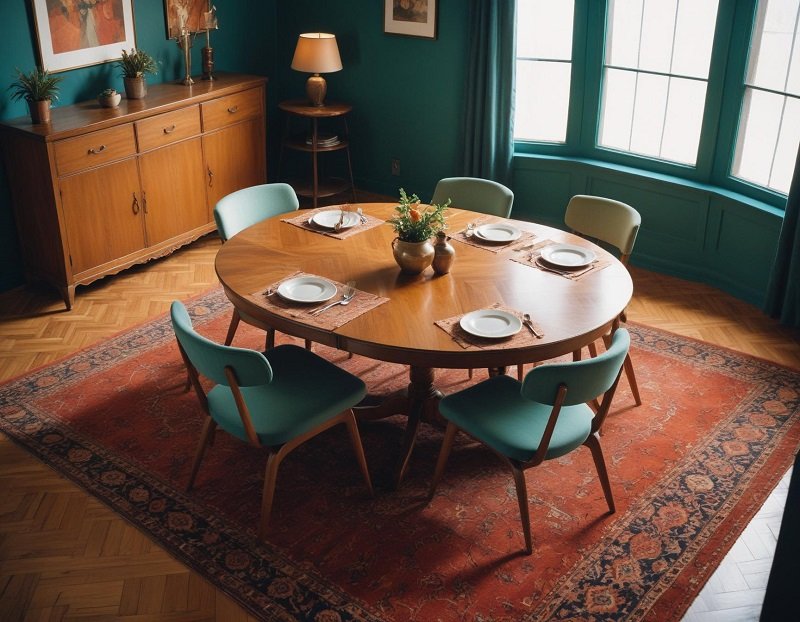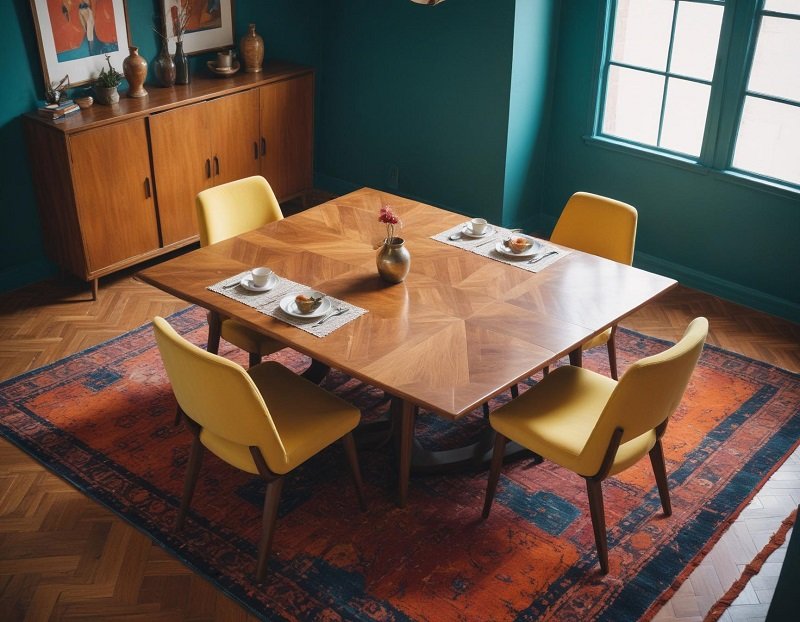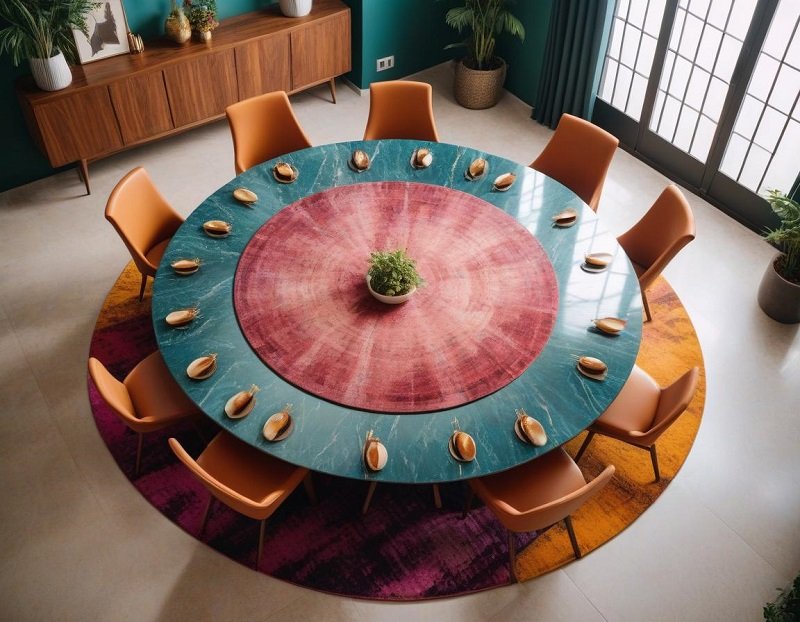Blog
How to Choose the Right Dining Table Rug?

Introduction
Imagine you’ve just set the table for a family supper. The dishes are properly lined, the silverware shines in the mild light, and the centerpiece—a vase of fresh flowers—adds an air of refinement. However, it appears like something is lacking. That’s when you realize the room’s atmosphere may benefit from a little something extra—a dining table rug that not only grounds the area but also improves its overall appearance.
Choosing the proper dining table rug may appear to be a little detail, but it has a huge impact on the overall mood of your dining room. The proper rug, like a perfect piece of jewelry to accent an outfit, unifies the space while also providing usefulness and flare. Whether you’re hosting a holiday feast or having a simple family meal, the correct rug may make a big impact.
But how can you choose the ideal rug that complements your dining table while showing your individual style? In this article, we’ll walk you through the process of choosing a dining table rug that compliments your room, fits your lifestyle, and is within your budget. Let’s go on a journey to turn your dining room into a place where every meal feels exceptional.
Why a Dining Room Rug?
When it comes to arranging your dining room, a rug may seem like a luxury rather than a need. However, bringing a rug into your dining room may provide several benefits, improving both the visual and functional elements of your space.
- Aesthetic Enhancement: Imagine your dining room as a blank canvas. The walls may be painted in a relaxing tone, and the furniture may be elegantly placed, but a rug can be the last touch that completes the image. A well-chosen rug serves as the focus, anchoring your dining table and providing a coherent design that connects the different aspects of the area.
- Comfort and warmth: A rug provides comfort and warmth to your eating area. Consider it like the velvety carpet in a fancy hotel room—soft underfoot, encouraging you to stay a bit longer. During the winter months, a rug helps protect your feet from frigid flooring, making dining more comfortable.
- Protection for Flooring: Rugs provide effective flooring protection in addition to aesthetic and comfort benefits. They assist in protecting your floors from spills, stains, and ordinary wear and tear. This is especially useful if your hardwood or tile flooring is prone to scratches and scuffs.
With these advantages in mind, it’s obvious why a dining room rug is more than simply a decorative accent—it’s a useful component that improves the whole eating experience. But how can you select the ideal rug to get these benefits? Let’s look at the essential factors to help you make the proper decision.
What to Consider When Purchasing Dining Room Rugs?
Choosing the best dining room rug requires a consideration of design, size, and functionality. Here’s a step-by-step guide to exploring the maze of possibilities and finding the ideal rug for your dining room.
The Right Size Rug
The size of your rug has a big impact on the overall look and feel of your dining area. A rug that is too little might make the dining room appear disjointed, but one that is too enormous can overpower the space.
- Measure Your Dining Table: Begin by measuring the length and width of your dining table. A decent rule of thumb is to select a rug that is at least 24-30 inches beyond the table on all sides. This enables comfortable chair movement while also ensuring that chairs remain on the rug even when pulled out.
- Consider Chair Movement: When choosing a rug size, consider how far your chairs move. For example, if your chairs are constantly pulled out, you’ll need a rug large enough to support this movement without causing the chairs to slide.
- Visualize the Space: Mark the measurements of the rug on the floor with painter’s tape. This might help you see how different sizes will fit in your room.
Color and Pattern
Enhancing Your décor: Your rug’s color and design should match your existing décor while also providing a personal touch. Rugs come in a variety of styles, ranging from bright and vivid to delicate and neutral.
Choosing the Right Color:
- Neutral Tones: If your dining room has a lot of patterns or strong colors, a neutral carpeting might help to balance things out. Colors like as beige, gray, or cream work well in these situations, providing a backdrop that highlights rather than overwhelms other design aspects.
- Brold Patterns: For a more dynamic appeal, choose carpets with bright patterns or colors. Geometric patterns, stripes, and elaborate designs may offer visual appeal and distinguish your dining room.
Choosing the Right Pattern:
- Classic Patterns: Traditional patterns, such as Persian or Oriental designs, may bring elegance and refinement to your dining room. They are appropriate for formal dining rooms and can complement traditional furniture choices.
- Modern Patterns: If your dining room has a contemporary feel, use modern patterns such as chevrons, abstract patterns, or even ombre effects. These designs may give your room a new, modern look.
Rug’s Shape
Aligning with Furniture: The form of your rug should be consistent with the shape of your dining table and the general arrangement of your space.
- Round rugs are ideal for round or oval dining tables because they soften the angles of the space and create a pleasant, intimate atmosphere. They work nicely in compact spaces or dining places that stand alone.
- Rectangular carpets are ideal for rectangular or oval dining tables since they mimic the shape of the table and offer a balanced appearance. They are adaptable and can accommodate a wide range of space sizes and layouts.
Cleaning and Maintenance of the Rug
Practical Considerations: Dining rooms are often prone to spills and stains, so it’s essential to choose a rug that’s easy to clean and maintain.
Rug Materials:
- Synthetic Fibers: Rugs produced from synthetic fibers, such as polypropylene or nylon, are long-lasting, stain-resistant, and easy to clean. They are an ideal solution for dining rooms where spills are likely.
- Natural fibers: Wool and cotton carpets provide a rich feel, but they may require more care. While they may be carefully cleaned, they are less stain-resistant than synthetic choices.
Cleaning Tips:
- Spot Cleaning: After an instant spill, tap the area with a clean towel to absorb extra liquid before addressing the stain. Avoid rubbing since it might spread the discoloration.
- Regular Vacuuming: Vacuuming on a regular basis to remove dirt and debris will help keep your carpeting looking fresh.
Cost
Budget Considerations: The dining room set price can vary widely based on factors like material, size, and brand.
Finding the Right Balance: While it’s tempting to opt for a high-end rug, it’s important to find a balance between quality and budget before paying the dining set price. Consider how much use the rug will get and choose a dining set price point that reflects its intended function and durability.
Conclusion
Choosing the proper dining table rug is about more than simply style; it’s an opportunity to improve your eating experience while also giving your home a coherent, professional appearance. The ideal rug may define your eating space, give comfort, and even protect your floors. By taking into account size, form, color, and material, you may discover a rug that not only compliments your dining set but also expresses your unique style and lifestyle.
As you begin on this adventure, try to strike a balance between beauty and functionality. Consider your requirements, tastes, and how the rug will work in your environment. Don’t forget to consider cleaning convenience and durability, especially if your house is busy.
FAQs
1- How do I choose the right size rug for my dining table?
Measure your dining table and add 24-30 inches on each side for chair movement. Use painter’s tape to visualize the size of your floor before purchasing.
2- What color rug should I choose for a neutral dining room?
Opt for a rug with a pattern or color that adds interest and complements existing decor. If your room is neutral, a rug with a subtle design or pop of color can enhance the space without overwhelming it.
3- Are round rugs suitable for rectangular dining tables?
Round rugs are generally best for round or oval tables. For rectangular tables, a rectangular rug usually provides a more cohesive look.
4- What material is best for a dining room rug prone to spills?
Synthetic fibers like polypropylene or nylon are ideal for high-traffic areas and spills due to their durability and stain resistance.
5- How can I maintain a high-pile rug in a dining area?
Regular vacuuming and professional cleaning are essential for maintaining high-pile rugs. Use a vacuum with a gentle brush to avoid damaging the fibers.
6- Can I use a dining room rug in a high-traffic area?
Yes, but choose a rug made from durable materials like synthetic fibers or low-pile options that can withstand frequent use and are easy to clean.
7- How do I prevent a rug from slipping under the dining table?
To prevent slipping, use a non-slip rug pad underneath the rug. This will keep the rug in place and provide additional cushioning, which is especially useful in high-traffic areas.
8- What should I consider if I have pets?
For homes with pets, choose a rug with a low pile and stain-resistant material. Synthetic rugs are often easier to clean and less likely to trap pet hair. Opt for patterns or colors that can camouflage pet hair and minor stains.
9- How can I coordinate my dining room rug with the rest of my decor?
Look at the colors and patterns in your dining area, including the walls, furniture, and accessories. Choose a rug that complements or contrasts with these elements. For example, if you have a colorful dining set, a rug with a more neutral tone might balance the space, while a patterned rug can add vibrancy to a more neutral room.
10- Are there any specific care instructions for cleaning wool rugs?
Yes, wool rugs should be cleaned gently to avoid damage. Use a vacuum with a brush attachment to remove dirt and debris. For stains, blot the area with a clean cloth and mild detergent, avoiding excessive moisture. Professional cleaning is recommended for deep or persistent stains to preserve the wool fibers.






